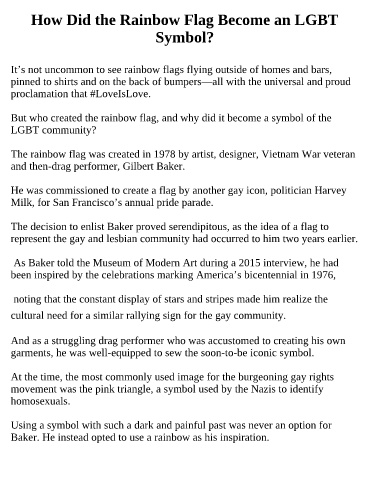Page 448 - ILIAS ATHANASIADIS AKA RO1
P. 448
How Did the Rainbow Flag Become an LGBT
Symbol?
It’s not uncommon to see rainbow flags flying outside of homes and bars,
pinned to shirts and on the back of bumpers—all with the universal and proud
proclamation that #LoveIsLove.
But who created the rainbow flag, and why did it become a symbol of the
LGBT community?
The rainbow flag was created in 1978 by artist, designer, Vietnam War veteran
and then-drag performer, Gilbert Baker.
He was commissioned to create a flag by another gay icon, politician Harvey
Milk, for San Francisco’s annual pride parade.
The decision to enlist Baker proved serendipitous, as the idea of a flag to
represent the gay and lesbian community had occurred to him two years earlier.
As Baker told the Museum of Modern Art during a 2015 interview, he had
been inspired by the celebrations marking America’s bicentennial in 1976,
noting that the constant display of stars and stripes made him realize the
cultural need for a similar rallying sign for the gay community.
And as a struggling drag performer who was accustomed to creating his own
garments, he was well-equipped to sew the soon-to-be iconic symbol.
At the time, the most commonly used image for the burgeoning gay rights
movement was the pink triangle, a symbol used by the Nazis to identify
homosexuals.
Using a symbol with such a dark and painful past was never an option for
Baker. He instead opted to use a rainbow as his inspiration.

